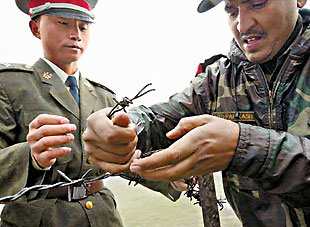China, India reopen border trade
By Xing Zhigang (China Daily)
Updated: 2006-07-06 05:56
China and India are today set to reopen a historic trading route through a
Himalayan pass that has been closed for 44 years a sign of warming relations
between the two most populous nations.
|
 |
|
Chinese and Indian soldiers check a barbed wire fence following a
meeting of military representatives of the two countries at their border
at the Nathula Pass yesterday, on the eve of the formal resumption of
trade between India and China along the pass.
[AFP] | The reopening of the Nathula pass demonstrates the two countries'
determination to strengthen economic and political exchanges, Chinese officials
and researchers said yesterday.
The 4,545-metre-high pass, which runs between India's state of Sikkim and
Yadong County of the Tibet Autonomous Region, was once part of an ancient trade
route and used to account for 80 per cent of Sino-Indian border trade.
The pass, which was closed after China and India fought a brief border war in
1962, is 460 kilometres from the Tibetan capital Lhasa and 550 kilometres from
Calcutta, India's second largest city.
Huang Xilian, director of the Department of Asian Affairs of the Foreign
Ministry, said a grand ceremony would be held at the pass today to mark the
resumption of border trade.
Huang told China Daily that markets have been set up on both sides of the
border to facilitate the resumption of bilateral overland trade.
The Chinese market, located at Renqinggang village of Yadong county, is 16.8
kilometres from the Nathula pass while the Indian market is at Changgu in
Sikkim, 17 kilometres from the pass.
"The two markets open only from April to September each year due to the
climate in the Himalayan region," Huang said.
Trading items are likely to include textiles, wool, herbs and consumer
electronics from China; and iron ore, livestock and car parts from India.
The reopening of the Nathula pass is based on a 2003 memorandum on expanding
bilateral border trade signed during a visit to China by then Indian Prime
Minister Atal Behari Vajpayee.
|